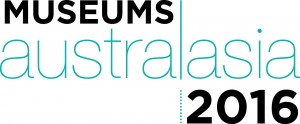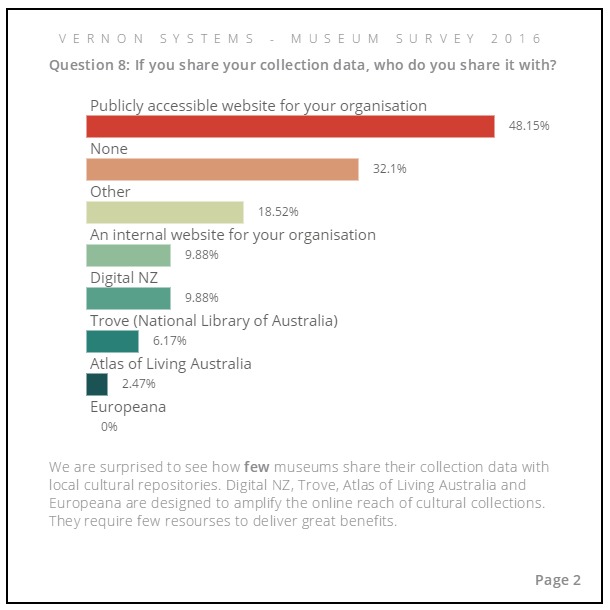Australia and New Zealand’s first ever combined Museums Australia and Museums Aotearoa conference has come to an end. The conference committee overcame the challenges of literally being an ocean apart, putting together a good mixture of presentation formats, tours and evening events. I’m pleased that Vernon Systems was able to help out with the conference in a small way as the conference partner sponsor.

The Australian and New Zealand museum sectors share a lot of the same challenges, so a combined conference was a good opportunity to all talk together in the same room. On Monday I briefly spoke about threats the museum sector was currently facing. The conference touched on many of the same themes and offered some more optimistic visions for the future.
Museums as knowledge creators
Museums usually have specialist subject areas in which they share knowledge. However, sites such as Wikipedia are increasingly the first destination for a casual researcher.
I cited The Dowse Art Museum’s project to add Wikipedia pages about New Zealand craft artists. The project takes the expertise and archives The Dowse has about the New Zealand craft industry and puts that knowledge where the most people can find it and make use of it. It’s a realistic way to balance the resources The Dowse has with a goal to reach a wider audience interested in New Zealand craft. It’s also an example of a project which any size of museum can follow, whether it’s improving the history section of a single Wikipedia page about your local town, or creating a wider range of completely new pages.
We can no longer expect that people will always go directly to our museums for education and discussion. Museums need to be where the conversations are taking place.
Improving design and development processes
In the session ‘Does consensus stifle innovation’, the panel discussed approaches for innovation in museums. Exhibitions can drain resources in an organisation and the panel talked about ways this might be improved. Michael Harvey from the Australian National Maritime Museum stated that when ideas for exhibitions are raised museums should question whether an exhibition is the best way to present that idea. Books, one-off lectures, and blog posts are ways in which the museum can more quickly present research and deliver the results to a wider variety of people. Seb Chan from the Australian Centre of the Moving Image argued for a more agile approach to exhibition design. Exhibitions could be trialed in smaller formats such as public programmes, with the failures and successes of these first steps helping to better direct the planning of a larger scale exhibition.
Seb also pushed for more skill sharing within the sector. By blogging about work in progress and sharing the problems and solutions they found, ACMI helps clarify its own thinking, gets feedback from others, and provides useful information for other GLAM organisations. You can read ACMI’s tech blog at ACMI Labs.
The Kaizen system for business process improvement and the Google Ventures Design Sprints process were both cited during the conference as ways to improve traditional museum activities such as exhibition or programme development.
The power of cooperation
The National Library of Australia build Trove, a centralised source for nearly 500 million Australian online resources including books, images, historic newspapers and more. Trove is an internationally acclaimed research and education resource and currently contains nearly 500 million items ranging from newspaper clippings to pictures of biplanes.
Australian governmental budget cuts have hit Trove this year. The National Library has been forced to pass on the costs for harvesting data from any new contributor. This will make it more difficult for organisations, particularly smaller ones, to join Trove. A ‘Save Trove’ petition has been started on Change.org.
Earlier this year we surveyed nearly 100 Australasian museums on how they share their collections online. A third of them have none of their collection information available online. Of the ones that do have collections online, half only share highlights of their collection and only one in five share with national initiatives like DigitalNZ and Trove. There’s also a separate post with the full details of our Australasian museums online collections survey.

These are missed opportunities. The greater the online access to your collection the greater the chance that your organisation will be a destination that people discover when exploring and searching online. Build upon sites like Trove and help demonstrate how sharing information has real social and economic benefit.
Entertainment vs Education
Museums increasingly compete with the film, music, and game industries as a destination for people who want to be entertained. However, fun and education are not mutually exclusive.
I had the pleasure of going to the “David Bowie Is” touring exhibition last year when it was at the Australian Centre of the Moving Image. The exhibition combines objects, personal stories and multimedia. For me the exhibition succeeded as both blockbuster entertainment and an in-depth view of Bowie’s history and influence. In contrast to the ‘kitten photo’ curators of Pinterest, museum curators have specialist expertise that helps interpret and use collections to their full potential.
Providing a rich experience, with collection objects as supporting material, as well as providing an environment where others are encouraged to share their own experiences, is an area where any size of museum has an important role to play.
This isn’t the domain of blockbusters – a well presented individual display can still capture a story. Blockbuster exhibitions pose their own challenges. Colleen Dilenschneider’s post ‘Death by Curation’ gives an excellent account of the negative effects of blockbusters.
The inclusive museum
Many of the conference presentations looked at ways to make museums more inclusive.
Moana Jackson delivered an emotional and thought provoking opening plenary session. He gave examples of how the colonial view of history filters through society, from memorial statues in towns to displays in our museums. Some voices in society are still silenced. Museums can help show a more balanced view of history and admit wrongs of the past.
Adrienne Leith talked about work Museums Victoria was doing to support children with autism. Their website includes a page on ‘The Autism-friendly Museum’ with tips for groups that include children on the autism spectrum. She also gave the example of Melbourne’s ‘Sensitive Santa’, a visit with Santa at Christmas that is specifically set up to be a quieter, low-key experience.
The conference was light on natural science presentations. Does this reflect the range of presentation submissions this year, or is there an inherit bias towards art and social history at national museum conferences?
Sundry tech tools to consider
Slack – Slack is being used at several larger museums, including Te Papa, the Australian National Maritime Museum and the Australian Centre for the Moving Image, to manage internal communication (and escape from email hell).
Live Labels – Auckland Museum has trialed using Kindles as a destination for e-ink display labels which can be updated in (near) real time.
Google Cardboard Virtual Reality – Google Cardboard provides a cheap introduction to virtual reality. The interactive Hieronymous Bosch app is an example of one of the apps you can access via Google Cardboard.
The future of museums
Make the most of conversations that this conference has sparked. Look for projects that can move your organisation a step towards one of these possible futures. From the conference I can see two key roles for museums in the future.
Museums as a place to access knowledge
Museum undertake research on many levels. Exhibitions have information panels and custom media created. Objects have catalogue records, display labels, and digital files. Public programmes and tours are developed. Blog posts, magazine articles and books are published.
Traditionally libraries have been viewed as points of access and museums as keepers. Provided people are able to find content created by museums where and when they need it, and have the ability to reuse this (within copyright limitations), museums will still be a resource that people turn to in the future.
Museums as places for open, multi-viewed discussions
Developing exhibitions and programmes that match points in the education curriculum is important for both funding and maintaining visitor numbers from schools. However, few topics are black and white, and museums are ideally placed to present additional contextual information. Earlier in the year the annual Alliance of American Museums conference highlighted the problem of traditional museums which are white, Western and “womanless”. Museums need to be diverse workplaces which provide a range of views on individual topics if they are to encourage open discussion and broaden their audience.
Next year’s conferences
The next Museums Australia conference will be at the Brisbane Conference and Exhibition Centre on May 14th-17th 2017. Curiously, the organisation appears to be going through a name change, although I couldn’t find any official statement on this. Both the conference and the Museums Australia website fall under the new name and logo of ‘Museums Galleries Australia’.
The next Museums Aotearoa conference will be hosted by Te Manawa in Palmerston North, provisionally in May 2017.
Thank you to all of the organisers and attendees who made this year’s conference a rewarding event.
Great going Paul We’ll be doing our write up soon as well.